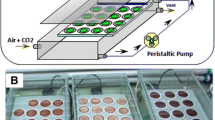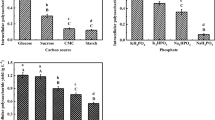Summary
Exocellular polysaccharide production byPorphyridium cruentum was studied in fed-batch cultures. Growth of the culture was characterized by a brief log phase, followed by a lineartype phase. The duration and the slope of the latter phase are largely dependent on culture conditions. The presence of polysaccharide in the culture medium was observed as soon as the log phase was over but the quantity did not become significant until the end of growth. Polysaccharide production depended on the cell number and the specific productivity. The cell number was affected mainly by the initial nitrogen and phosphorus concentrations and the specific productivity by the aeration and agitation systems. Other environmental conditions had no significant effect on polysaccharide production. Under photoperiodic illumination the oscillations in cell volume observed after the log phase may indicate a synchronization of polysaccharide synthesis and/or excretion with the light period and the solubilization with the dark period.
Résumé
La production de polysaccharide parPorphyridium cruentum a été étudiée au cours de cultures ‘fed-batch’. La croissance d'une culture est caractérisée par une courte phase log suivie d'une phase de type linéaire. La durée et la pente de cette dernière phase dépendant beaucoup des conditions de culture. La présence de polysaccharide dans le milieu de culture a été observée dès la fin de la phase log mais elle ne devient importante qu'à la fin de la croissance. La production de polysaccharide parait être fonction du nombre de cellules et de la productivité spécifique: le nombre de cellules est essentiellement affecté par les concentrations en nitrates et phosphates du milieu de culture, la productivité spécifique par les systèmes d'aération et d'agitation. Les autres conditions testées n'ont pas eu d'influence significative sur la production de polysaccharide.
Resumen
La producción de polisaccáridos exocelulares porPorphiridium cruentum se estudió en cultivos ‘fed-batch’. El crecimiento del cultivo se caracterizó por una breve fase log seguida por una fase de tipo linear. La duración y la pendiente de esta última fase son en gran parte dependientes de las condiciones de cultivo. La presencia de polisaccáridos se observó tan pronto como se hubo terminado la fase log, sin embargo cantidades significativas de éstos no se obtuvieron hasta el final del crecimiento. La producción de polisaccáridos dependió del número de células y de la producción específica. El número de células se vió afectado principalmente por la concentración inicial de fósforo y de nitrógeno. La productividad específica lo fue por los sistemas de aeración y de agitación. No se observó que otras condiciones del medio tuvieran efecto significativo alguno sobre la producción de polisaccáridos.
Similar content being viewed by others
References
BRODY, M. & EMERSON, R. 1959 The effect of wavelength and intensity of light on the proportion of pigments inPorphyridium cruentum.American Journal of Botany 46, 433–440.
COLMAN, B. & GEHL, K. A. 1983 Physiological characteristics of photosynthesis inPorphyridium cruentum: evidence for bicarbonate transport in a unicellular red alga.Journal of Phycology 19, 216–219.
GANTT, E. & LIPSCHULTZ, A. 1972 Phycobilisomes ofPorphyridium cruentum. 1. Isolation.Journal of Cell Biology 54, 313–324.
GUERIN-DUMARTRAIT, E., LECLERC, J. C. & HOARAU, J. 1973 Effets de la lumière rouge et de la carence en azote sur la composition pigmentaire (phycoery thine, holochromes chlorophylliens) et l'émission d'O2 photosynthétique dePorphyridium sp.Archives of Hydrobiology 39, 317–332.
GENSE, M. T., GUERIN-DUMARTRAIT, E., LECLERC, J. C. & MIHARA, S. 1969 Synchronisation dePorphyridium: evolution des quantités de pigments et de la capacité photosynthétique au cours du cycle biologique.Phycologia 8, 135–141.
HEANY-KIERAS, J. & CHAPMAN, D. J. 1976 Structural studies on the extracellular polysaccharide of the red alga,Porphyridium cruentum.Carbohydrate Research 52, 169–177.
HEMERICK, G. 1973 Culture methods and growth measurements. InHandbook of Phycological Methods, ed. Stein, J. R. p. 260. Cambridge: Cambridge University Press.
JONES, R. F., SPEER, H. L. & KURY, W. 1963 Studies on the growth of the red algaPorphyridium cruentum.Physicologia Plantarum 16, 636.
LECLERC, J. C. 1967 Sur la croissance et la photosynthèse dePorphyridium, en fonction de la salinité du milieu du culture.Photosynthetica 1, 179–191.
MEDCALF, D. G., SCOTT, J. R., BRANNON, J. H., HEMERICK, G. A., CUNNINGHAM, R. L., CHESSEN, J. H. & SHAH, J. 1975 Some structural features and viscosimetric properties of the extracellular polysaccharide fromPorphyridium cruentum.Carbohydrate Research 44, 87–96.
PERCIVAL, E. 1979 The polysaccharides of green, red and brown seaweeds: their basic structure, biosynthesis and function.British Phycological Journal 14, 103–117.
PRINGSHEIM, E. G. & PRINGSHEIM, O. 1949 The growth requirements ofPorphyridium cruentum with remarks on the ecology of brackish water algae.Journal of Ecology 37, 57–64.
RAMUS, J. 1972 The production of extracellular polysaccharide by the unicellular red algaPorphyridium aerugineum.Journal of Phycology 8, 97–111.
RAMUS, J. & ROBINS, D. M. 1975 The correlation of Golgi activity and polysaccharide secretion inPorphyridium.Journal of Phycology 11, 70–74.
SCHENK, P., FOSTER, P. L., WALKER, W. W. & FOGEL, J. et S. 1976 Production de biopolymères par culture d'algues. U.S. patent No. 421.527.
SHEATH, R. G. & HELLEBUST, J. A. 1979 Floridean starch metabolism ofPorphyridium purpureum II: changes during the cell cycle.Phycologia 18, 185–190.
SOMMERFELD, H. R. & NICHOLS, H.W. 1970 Comparative studies on the genusPorphyridium Naeg.Journal of Phycology 6, 67–78.
Author information
Authors and Affiliations
Rights and permissions
About this article
Cite this article
Thepenier, C., Gudin, C. Studies on optimal conditions for polysaccharide production byPorphyridium cruentum . World J Microbiol Biotechnol 1, 257–268 (1985). https://doi.org/10.1007/BF01742320
Received:
Accepted:
Issue Date:
DOI: https://doi.org/10.1007/BF01742320




